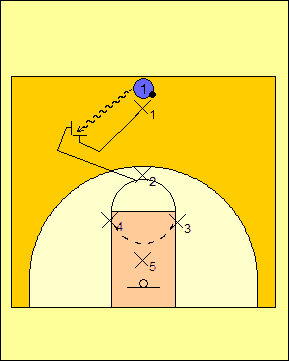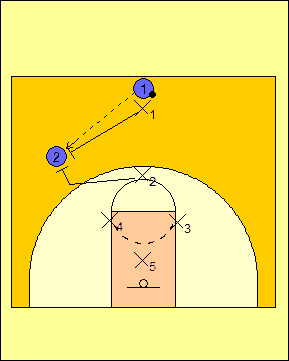In the late 1980's and the early 1990's, UNLV had some
of the best teams in the history of college basketball which included
three Final Four trips in a five-year period including the national
championship in 1990. The key to their success was their defense
that was able to take teams out of their offense and apply extreme
pressure in the half court. That defense was the Amoeba Defense.
Because of this defense, UNLV was able to force bad shots and turnovers
that led to run outs in transition.
The defense is set up as shown in Diagram 1. X1 is just inside the
half-court circle and will pick up the ball at half court. X2 sets up at
the top of the free throw circle while X3 and X4 position themselves just below
the elbows. X5 is just in front of the basket.
There are two ways that the defense can set up. The first is to
guard the ball straight up as shown in Diagram 2. We want X1 to
pick up the ball at half court and then get into his path to force the
change of direction by the dribbler.
We also have the option to trap with X1 and X2 setting the trap. This can
be done either off of the dribble (Diagram 3) or off of the pass (Diagram 4).
Whenever we set a trap, X3 and X4 are the interceptors and X5 protects the
basket.

Diagram
3 |

Diagram
4 |
If the defense decides to avoid the trap of the
point guard by X1 and X2, they will look to enter the ball at the
wing. There are two ways that this can be defended. The
first of these is to point the ball with X4 and have X5 front the
low post (Diagram 5). X3 steps into the middle of the lane and
X1 drops to the nail. Meanwhile, X2 denies the pass back to
the point guard.
The other is to trap the wing as shown in Diagram 6.
X2 and X4 set the trap while X1, X3, and X5 assume the same
responsibilities as if we were not going to set the trap.

Diagram
5 |

Diagram
6 |
If we play straight up and the ball is passed from
wing to corner, we will adjust to take away the pass back to the
wing as shown in Diagram 7. X4 denies the pass as X5 points
the ball. X3 will front the low post while X2 fronts the high
post. At this point, X1 is responsible for guarding the
basket.

Diagram
7 |
If the player in the corner decides to put the ball
on the floor, we will trap in the short corner. Continuing
from the set up after the pass is made in Diagram 7, the trap gets
set by X3 and X5 in the short corner as shown in Diagram 8.
X1, X2, and X4 are in the same responsibilities as they were at the
conclusion of Diagram 7.

Diagram
8 |
If #1 brings the ball up and passes directly into
the corner, X4 must be in a position to guard the receiver of the
pass (Diagram 9). X2 drops to the ball-side elbow, X5 fronts
the low post and X3 protects the basket. X1's job is to deny
the pass back to #1.

Diagram
9 |
If the player in the corner decides to put the ball
on the floor, it is important that we support the on-ball defense.
In Diagram 10, X5 steps in to stop the ball and set up a trap on the
baseline. X3 must be in a place to protect the basket.

Diagram
10 |
Teaching the Amoeba Defense
The defensive set up starts with the zig-zag drill
to work on pointing the ball and applying pressure to the
basketball. The next part of the defense is walking through
the options and placing an emphasis on denying the ball back to the
point. Finally, we will put in the traps and the support on
baseline drives from X5.